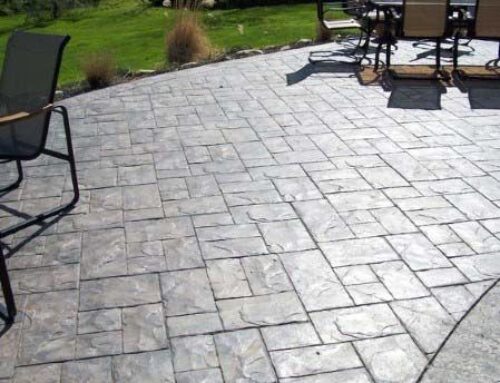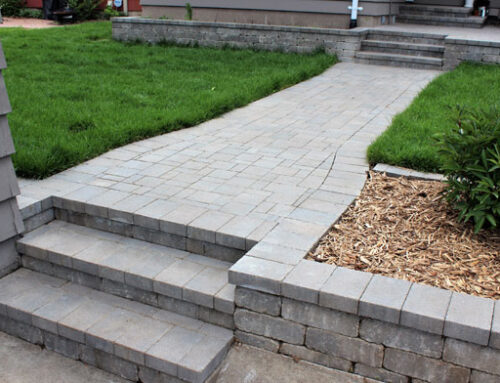One of the most important parts of having a well-maintained home is having a properly poured sidewalk. Not only does a poured sidewalk add to the curb appeal of your home, but it can also increase its value.
But what exactly is involved in sidewalk pouring? In this article, we’ll take a look at everything you need to know about sidewalk pouring, from the basics of concrete to the different types of edging. By the end, you’ll be an expert on all things sidewalk-related!
What Is Concrete?
Concrete is a building material made from a mixture of cement, water, sand, and gravel. It is widely used for construction purposes due to its durability and strength. When concrete is first mixed, it is in a liquid form. However, it quickly begins to harden and set into a solid-state.
Concrete is often used for sidewalks because it is a durable material that can withstand heavy foot traffic and weather conditions. It is also relatively easy to maintain, as it does not require much more than occasional sweeping and mopping.
Types Of Concrete Sidewalks
There are two main types of concrete sidewalks: pre-cast and poured. Precast concrete sidewalks are created by pouring concrete into mold forms. Once the concrete has hardened, the mold forms are removed, and the sidewalk is ready for use.
On the other hand, poured concrete sidewalks are created by pouring concrete directly onto the ground, where it will harden. Poured sidewalks are generally more durable than precast sidewalks and often have a more polished look.
Concrete Edging
There are two main types of concrete edging: stamped and stenciled. Stamped concrete edging is created by using a mold to imprint a design onto the wet concrete. Once the concrete has hardened, the mold is removed, and the design is revealed.
Stenciled concrete edging is created by placing a stencil onto the wet concrete and then spraying it with a colored pigment. Once the concrete has hardened, the stencil is removed, revealing the design.
Pouring Your Sidewalk
If you’re planning on pouring your own sidewalk, there are a few things you’ll need to do first. First, you’ll need to clear the area where you’ll be pouring the concrete. This means removing any grass, weeds, or debris that may be in the way.
Next, you’ll need to mark out the perimeter of your sidewalk with stakes and string. Once you have the perimeter marked out, you’ll need to excavate the area within the perimeter. The depth of your excavation will depend on the thickness of your desired sidewalk.
Once you’ve excavated the area, you’ll need to compact the soil so that it is firm enough to support your sidewalk. You can do this by using a hand tamper or a gas-powered plate compactor.
After compacting the soil, you’re ready to start pouring your concrete. Be sure to follow the instructions on your concrete mix, as every brand is different. Once you’ve poured the concrete, you’ll need to level it off with a rake.
Finally, you’ll need to smooth out the surface of your sidewalk with a float. A float is a tool that looks like a large piece of foam. Once you’ve smoothed out the surface, you’re ready to add your chosen type of edging.
Consider the Steps Before Committing to DIY Installation
Pouring a concrete sidewalk is a big job. If you’re not confident in your ability to do it yourself, you may want to consider hiring a professional.
If you do decide to pour your own sidewalk, be sure to take the time to plan and prepare for the job. By taking the proper steps, you can ensure that your sidewalk will be durable and long-lasting.
There are many risks involved in pouring your own sidewalk. If you’re not careful, you could end up with a low-quality sidewalk that cracks and crumbles over time.
When it comes to concrete, it’s always better to err on the side of caution. If you’re not confident in your ability to pour a high-quality sidewalk, it’s best to hire a professional.
How to Find a Reputable Paving Contractor
If you decide to hire a professional to pour your sidewalk, it’s important to find a reputable contractor. There are many paving contractors out there, but not all of them are created equal.
When looking for a paving contractor, be sure to ask for referrals from friends, family, and neighbors. You can also check online review sites like Angie’s List and Home Advisor.
Once you have a few options, be sure to get estimates from each contractor. Be sure to ask about the quality of their concrete mix, as well as the thickness of their sidewalks.
Finally, be sure to ask about the warranty that each contractor offers. A good paving contractor should offer a warranty on their work.
Pouring a concrete sidewalk is a big job, but it’s one that you can do yourself if you’re careful and take the time to prepare. If you decide to hire a professional, be sure to find a reputable contractor who offers a warranty on their work.
Final Thoughts
Pouring a concrete sidewalk is a big job, but it’s one that you can do yourself if you’re careful and take the time to prepare. If you decide to hire a professional, be sure to find a reputable contractor who offers a warranty on their work.
Don’t wait too long to have your sidewalk poured, as the soil beneath it can settle, causing the concrete to crack. Be sure to compact the soil before you pour the concrete, and be sure to follow the instructions on your concrete mix. By taking these precautions, you can ensure that your sidewalk will be durable and long-lasting.





